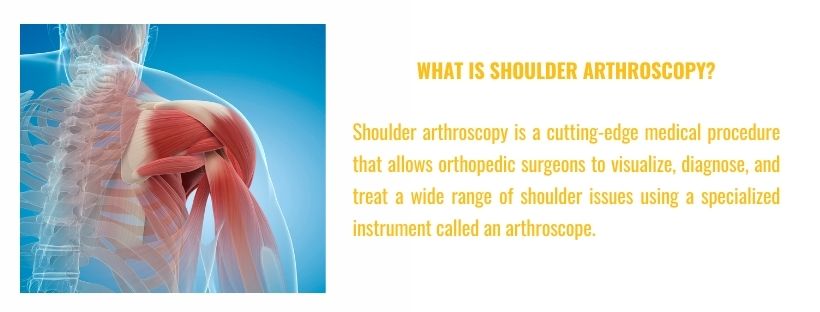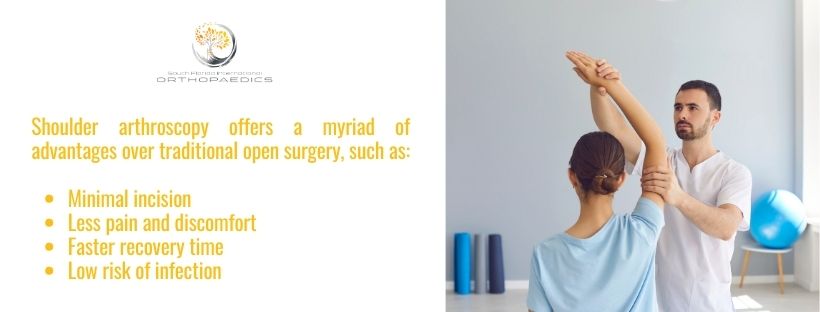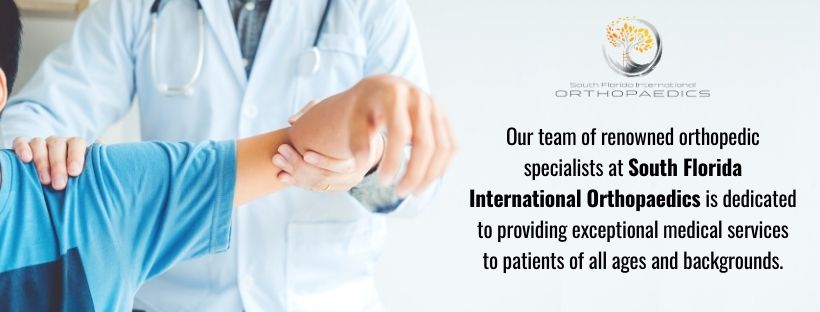Have you ever wondered how modern medicine can work wonders with just a tiny camera and some small incisions? Shoulder arthroscopy is one such marvel, a minimally invasive surgical technique that has revolutionized the treatment of various shoulder conditions.

In this blog, we’ll take you on an exciting journey into the world of shoulder arthroscopy, uncovering its benefits, risks, and everything you need to know before undergoing this procedure.
What is shoulder arthroscopy?
Shoulder arthroscopy is a cutting-edge medical procedure that allows orthopedic surgeons to visualize, diagnose, and treat a wide range of shoulder issues using a specialized instrument called an arthroscope.
This small camera, mounted on a slender tube, is inserted into the shoulder joint through tiny incisions. The arthroscope’s high-definition camera provides the surgeon with a clear view of the inside of the shoulder joint, including the cartilage, tendons, ligaments, and bones.
The live images captured by the arthroscope help the surgeon diagnose any abnormalities or injuries in the shoulder joint. Furthermore, it can also aid them in performing corrective procedures using other small surgical instruments inserted through additional incisions.
Why is shoulder arthroscopy performed?
Shoulder arthroscopy is a versatile procedure that can address various shoulder problems with great success. Some of the common conditions treated with shoulder arthroscopy include:
- Rotator cuff tears
- Shoulder impingement
- Labral Tears
- Shoulder instability
- Frozen shoulder
- Biceps tendon injuries
- Arthritis
Shoulder arthroscopy is performed when conservative treatments, such as rest, physical therapy, and medications, have failed to provide relief for shoulder pain or dysfunction.
What are the advantages of shoulder arthroscopy?
Shoulder arthroscopy offers a myriad of advantages over traditional open surgery, making it an attractive option for both patients and surgeons:
Minimal incisions
Unlike traditional open surgery, which requires large incisions, arthroscopy uses small incisions (usually about 0.5 to 1 centimeter in length). These smaller incisions result in less tissue damage, reduced scarring, and faster healing.
Less pain and discomfort
The smaller incisions and reduced tissue trauma associated with arthroscopy result in less post-operative pain and discomfort than open surgery.
Faster recovery
Since it is only minimally invasive, patients typically experience shorter hospital stays and quicker recovery times. Many individuals can resume light activities within a few days, with a gradual return to full functionality after a few weeks to months.
Lower infection risk
The smaller incisions used in arthroscopy reduce the risk of infection compared to traditional open surgery, where larger incisions provide more entry points for bacteria.
Outpatient procedure
In many cases, shoulder arthroscopy is performed as an outpatient procedure, meaning patients can return home on the same day as the surgery, reducing the overall cost and inconvenience associated with a hospital stay.
What are the risks and complications?
Shoulder arthroscopy is generally safe and associated with fewer risks than open surgery. However, it does carry some potential complications, as with any surgical procedure. Some of the potential risks and complications of shoulder arthroscopy include:
- Risk of infection
- Nerve and blood vessel damage
- Shoulder stiffness due to scar tissues (can be prevented through physical therapy)
- Blood clots
- Allergic reaction to anesthesia
It’s essential for patients to discuss their individual health conditions and potential risk factors with their surgeon to understand the specific risks associated with their shoulder arthroscopy.
How is shoulder arthroscopy performed?
Shoulder arthroscopy involves several stages, including preparation, the procedure itself, and post-operative care. Let’s delve into each of these stages:
A. How to prepare for shoulder arthroscopy?
Preparing for shoulder arthroscopy is essential to ensure a smooth procedure and recovery. Here’s what you can expect during the preparation phase:
-
Medical evaluation
Your orthopedic surgeon will thoroughly examine your medical history to assess your suitability for the procedure. They will ask about any underlying health conditions, medications you are taking, and any allergies you may have.
-
Imaging tests
X-rays, magnetic resonance imaging (MRI), or ultrasound may be performed to obtain detailed images of your shoulder joint. This will aid in the diagnosis and planning of the surgical procedure.
-
Pre-operative instructions
Your surgeon will provide specific guidelines on how to prepare for the surgery. This may include bathing or showering with antibacterial soap the night before or the morning of the procedure to reduce the risk of infection.
-
Arranging transportation
As shoulder arthroscopy is typically performed on an outpatient basis, you’ll need to arrange for someone to drive you home after the procedure.
You can contribute to the success of the surgery and reduce the risk of complications by following your surgeon’s pre-operative instructions carefully.

B. What to expect during the procedure
On the day of the surgery, you’ll be prepped for the procedure and taken to the operating room. Here’s what you can expect during the shoulder arthroscopy procedure:
-
Anesthesia
Before the surgery begins, you’ll be given anesthesia to ensure you’re comfortable and pain-free during the procedure. Your anesthesia options may include general or regional anesthesia.
-
Incision and arthroscope insertion
Once adequately anesthetized, the surgeon will make small incisions (usually 0.5 to 1 centimeter) around the shoulder joint. These incisions serve as entry points for the arthroscope and other surgical instruments.
-
Surgical interventions
The arthroscope is inserted through one of the incisions. Depending on the diagnosis, the surgeon may perform various surgical interventions using additional small instruments inserted through other incisions.
These interventions may include repairing torn tendons, removing damaged tissues, shaving bone spurs, or tightening loose ligaments.
Once the necessary repairs or treatments are complete, the surgeon will remove the arthroscope and other instruments, and the small incisions will be closed with sutures or adhesive strips.
-
Dressing and recovery
Your shoulder will be dressed with bandages, and you will be moved to a recovery area where you’ll be closely monitored as you wake up from the anesthesia.
C. What to expect after the procedure?
After the surgery, you’ll be moved to a recovery area, where medical staff will closely monitor your vital signs and assess your response to the procedure. Here’s what you can expect during the recovery phase:
-
Pain and discomfort
Immediately after the procedure, you may experience some pain and discomfort. Pain medications will be administered to manage your post-operative pain effectively.
-
Use of a sling
Your surgeon may provide a sling to support and protect your shoulder during the initial recovery phase. The length of time you’ll need to wear the sling will depend on your specific case.
-
Post-operative instructions
Your surgeon will provide detailed post-operative instructions, including wound care, activity restrictions, and when to start physical therapy.
-
Physical therapy and rehabilitation
Physical therapy plays a crucial role in restoring strength, flexibility, and mobility to your shoulder joint. Your surgeon will provide a customized rehabilitation plan to aid your recovery.
Physical therapy sessions may include exercises to strengthen the shoulder muscles, improve range of motion, and promote healing.
-
Gradual return to activities
As your shoulder heals, you’ll gradually increase the intensity of your activities and exercises under the guidance of your physical therapist.
Avoiding excessive strain or force on the shoulder during the early stages of recovery is crucial to prevent complications.
-
Follow-up appointments
Your surgeon will schedule follow-up appointments to monitor your progress, assess your shoulder’s healing, and make necessary adjustments to your rehabilitation plan.
-
Work and driving
The timing of returning to work and driving will depend on the nature of your job, the extent of the surgery, and your overall recovery progress.
Some patients can return to work within a few days to a few weeks, while others may need more time, especially if their job requires heavy lifting or physical exertion.
Where to find the best shoulder specialist in Miami?

Are you in need of specialized orthopedic care? Look no further than South Florida International Orthopaedics, where our team of renowned orthopedic specialists is dedicated to providing exceptional medical services to patients of all ages and backgrounds.
From sports injuries to complex joint replacements, our practice offers a wide range of orthopedic services to address various musculoskeletal conditions.
We provide personalized treatment plans tailored to your unique needs, ensuring optimal outcomes and a swift return to an active and pain-free life.
Contact South Florida Orthopedics at our Miami office (305) 233-0011 or the Homestead office (305) 247-1701 to get in touch with the best Miami sports medicine facility.
The material contained on this site is for informational purposes only and DOES NOT CONSTITUTE THE PROVIDING OF MEDICAL ADVICE, and is not intended to be a substitute for independent professional medical judgment, advice, diagnosis, or treatment. Always seek the advice of your physician or other qualified healthcare providers with any questions or concerns you may have regarding your health.
